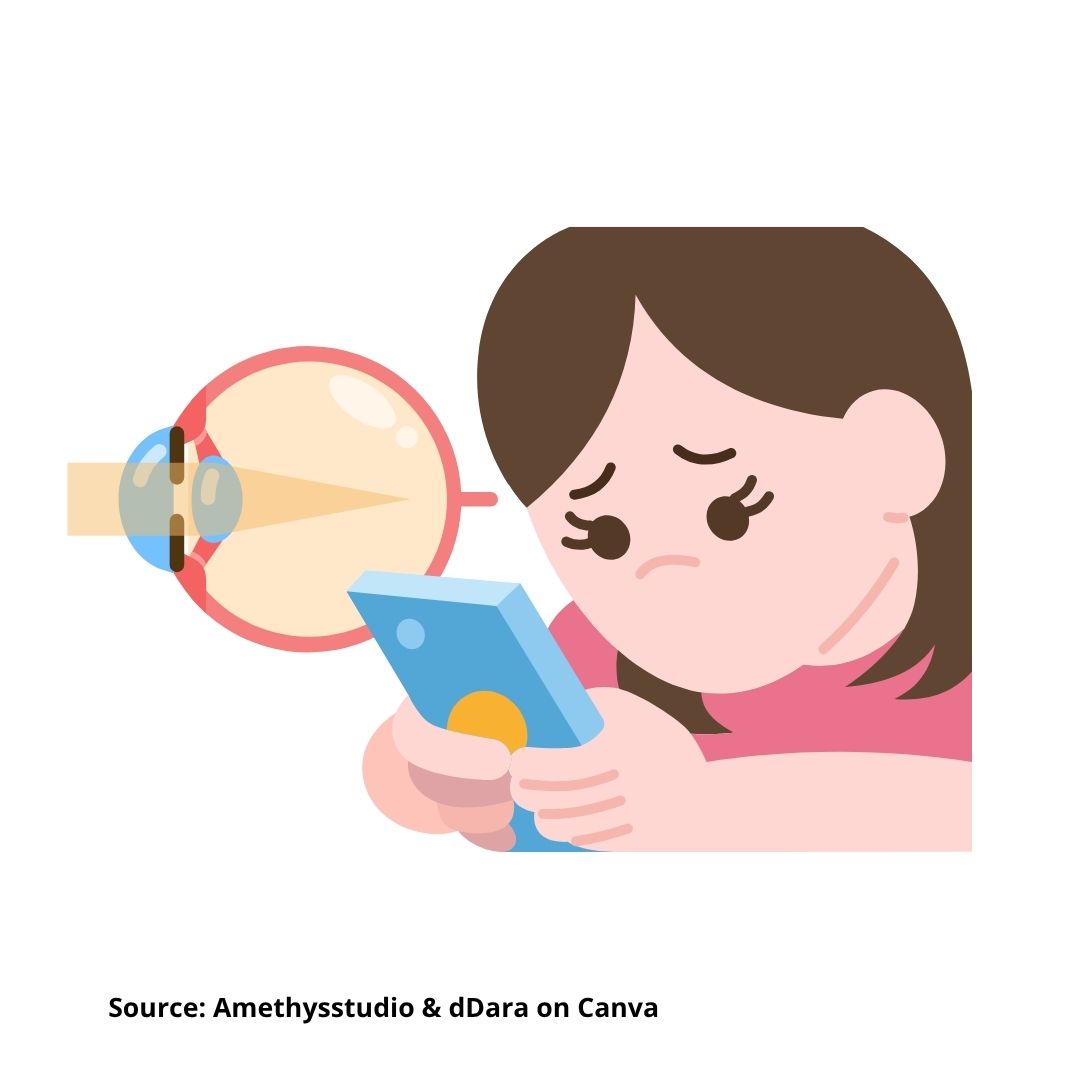SMARTPHONE USAGE AS A RISK FACTOR OF MYOPIA AMONG ELEMENTARY SCHOOL STUDENTS IN KEDIRI
Penggunaan Smartphone Sebagai Faktor Risiko Miopia Pada Anak Sekolah Dasar di Kota Kediri

Downloads
Background: Myopia is the inability to view distant objects. Most cases of myopia occur in school-age children. Working and studying from home due to the COVID-19 epidemic exacerbates myopia concerns. The Kediri City Health Office reports that school-age myopia cases rose in 2022. Purpose: This study aims to identify the risk factors of myopia related to smartphone usage among elementary school students in Kediri City. Method: This study is an observational study with a case-control approach. Random sampling is used in the sampling procedure. There were 144 participants: 72 students in the case group and 72 in the control group. Independent variables include smartphone duration, using a smartphone in a low-light environment, using a smartphone before sleep, and using a smartphone at an early age. Result: The study's findings revealed all factors were associated with myopia: smartphone duration (p-value = 0.001; OR = 4.5), using smartphone in low-light environment (p-value = 0.001; OR = 3.4), using smartphone before sleep (p-value = 0.001; OR = 3.3), and using smartphone in early age (p-value = 0.000; OR = 12. 4). Conclusion: This study shows that the duration of smartphone use of more than 3 hours increases the risk by 4.5 times, using a smartphone in low-light environment increases the risk by 3.4 times, using a smartphone before bed increases the risk by 3.3 times, and the risk of myopia increases 12.4 times for smartphone use at a younger age in elementary school students in Kediri City.
Baird PN, Saw SM, Lanca C, Guggenheim JA, Smith III EL, Zhou X, et al. Myopia. Nat Rev Dis Prim [Internet]. 2020 Dec 17;6(1):99. icles/s41572-020-00231-4
Flitcroft DI, He M, Jonas JB, Jong M, Naidoo K, Ohno-Matsui K, et al. IMI – Defining and classifying myopia: a proposed set of standards for clinical and epidemiologic studies. Invest Ophthalmol Vis Sci [Internet]. 2019 Feb 1;60(3):M20.
Sankaridurg P, Tahhan N, Kandel H, Naduvilath T, Zou H, Frick KD, et al. IMI impact of myopia. Invest Ophthalmol Vis Sci. 2021;62(5):2.
Congdon N, Burnett A, Frick K. The impact of uncorrected myopia on individuals and society. Community eye Heal. 2019;32(105):7.
Ang M, Wong TY. Updates on myopia: a clinical perspective. Springer Nature; 2020.
Németh J, Aclimandos WA, Tapasztó B, Jonas JB, Grzybowski A, Nagy ZZ. The impact of the pandemic highlights the urgent need for myopia guidelines: the clinicians’ role. Vol. 33, European Journal of Ophthalmology. SAGE Publications Sage UK: London, England; 2023. p. 633–6.
Wang M, Cui J, Shan G, Peng X, Pan L, Yan Z, et al. Prevalence and risk factors of refractive error: a cross-sectional Study in Han and Yi adults in Yunnan, China. BMC Ophthalmol. 2019;19:1–12.
Ueda E, Yasuda M, Fujiwara K, Hashimoto S, Ohno-Matsui K, Hata J, et al. Trends in the prevalence of myopia and myopic maculopathy in a Japanese population: the Hisayama study. Invest Ophthalmol Vis Sci. 2019;60(8):2781–6.
Wulandari M, Mahadini C. Chengqi, Tongziliao and Yintang point acupuncture in improving the case of myopia visus. J Vocat Heal Stud. 2018;2(2):56–9.
Aslan F, Sahinoglu-Keskek N. The effect of home education on myopia progression in children during the COVID-19 pandemic. Eye. 2022;36(7):1427–32.
Luo Z, Guo C, Yang X, Zhang M. Comparison of myopia progression among Chinese schoolchildren before and during COVID-19 pandemic: a meta-analysis. Int Ophthalmol. 2023;43(10):3911–21.
McCrann S, Loughman J, Butler JS, Paudel N, Flitcroft DI. Smartphone use as a possible risk factor for myopia. Clin Exp Optom. 2021;104(1):35–41.
Foreman J, Salim AT, Praveen A, Fonseka D, Ting DSW, He MG, et al. Association between digital smart device use and myopia: a systematic review and meta-analysis. Lancet Digit Heal. 2021;3(12):e806–18.
Song R, Wang Y, Kong Y, Fan X, Yuan C, Zha X. Causal associations between mobile phone usage and glaucoma risk: A Mendelian randomization study. Medicine (Baltimore). 2024;103(48):e40666.
Puchalska-Niedbał L, Czajkowski J, Grabowski R. Smartphones and vision. Adv Hyg Exp Med Hig i Med Dosw. 2020;74.
Wang XX, Liu X, Lin Q, Dong P, Wei Y Bin, Liu JJ. Association between sleep duration, sleep quality, bedtime and myopia: A systematic review and meta‐analysis. Clin Experiment Ophthalmol. 2023;51(7):673–84.
Kurupp ARC, Raju A, Luthra G, Shahbaz M, Almatooq H, Foucambert P, et al. The impact of the COVID-19 pandemic on myopia progression in children: a systematic review. Cureus. 2022;14(8).
Lemenager T, Neissner M, Koopmann A, Reinhard I, Georgiadou E, Müller A, et al. COVID-19 lockdown restrictions and online media consumption in Germany. Int J Environ Res Public Health. 2021;18(1):14.
Zhang D, Wang L, Jin L, Wen Y, Zhang X, Zhang L, et al. A review of intraocular pressure (IOP) and axial myopia. J Ophthalmol. 2022;2022(1):5626479.
Aliviana B. The relationship between the axial length of the eyeball and the degree of myopia with intraocular pressure. Med Heal Sci J. 2020;4(1):13–8.
Verkicharla PK, Kammari P, Das AV. Myopia progression varies with age and severity of myopia. PLoS One. 2020;15(11):e0241759.
- Every manuscript submitted to must observe the policy and terms set by the Jurnal Berkala Epidemiologi
- Publication rights to manuscript content published by the Jurnal Berkala Epidemiologi is owned by the journal with the consent and approval of the author(s) concerned. (download copyright agreement)
- Complete texts of electronically published manuscripts can be accessed free of charge if used for educational and research purposes according to copyright regulations.

JBE by Universitas Airlangga is licensed under a Creative Commons Attribution-ShareAlike 4.0 International License.























